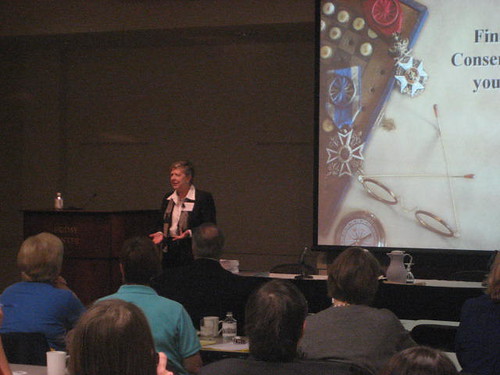This article is more than 5 years old.
NCPC Annual Conference Fundraising for Preservation
Nov. 13, 2009 Friday Center Chapel Hill, NC
As NCPC President, I had the pleasure of welcoming 50 attendees and talking about NCPC projects and grants in the past year. NCPC gave over $6,000 in grants last year, two of which were to institutions in Forsyth County (WFU Museum of Anthropology and Forsyth Co. Public Library). I was also able to meet two colleagues from the WFU Anthropology Museum who attended the conference .
The first speaker (who once worked at Wayne State) was:
Diane Vogt O’Connor– Chief of Conservation, Library of Congress
“Finding Funds to Conserve and Preserve your Collections:
Diane has written over 25 successful grants in her career.
Her key points were:
•Everyone needs money these days
•Start by getting permission from your organization
•Identify and sell the CONCEPT(who it affects) not the BRAND (how you will do the work)
•Tell your grant funder what will happen if the project isn’t funded-you are answering the question-why bother with this project?
•Research where the easy money in your community is. Look for groups that share your interests and concerns, and look for what they have funded in the past
•Network and make contacts, so they know who you are and what you do…schmooze
•Know what’s hot and what’s not-select projects that are trendy, new technologies
•Pre-plan your project completely
•Avoid the obvious sources of funding and look at foundations nationally and locally
•NC grant sources- Duke Endowment, Foundation for the Carolinas, Janirve Foundation, Lowes Foundation
•Become a grant reviewer to learn what grant funders are looking for
•She recommended this book-Foundation Grants for Preservation in Libraries, Archives and Museums-Library of Congress, Foundation Center(2009) ISBN 978-1-59542-210-1
•A good application includes:
•Strong statement of who the project audience and stakeholders are
•A clear explanation of why the project is necessary
•A succinct statement of what will happen if the project is not funded
•A brief overview of all project staff members
•A summary of what the project results will be
•A statement about how the project results will be measurable and how they will be disseminated
•A brief project methodology
•Coherent budget and resources list
•List of endorsing individuals
•Staff and contributor resumes, CV’s, etc.
Kristen Laise, Heritage Preservation, VP Collections Care Programs
“Raising Funds for Collections Care”
•Few institutions have a budget for conservation/preservation and many do not raise funds for this purpose. Some do not have time, are unaware of sources for funding or said preservation was not a priority. Preservation awareness (programs, web site, exhibits, etc) is also not often used to raise awareness about this issue.
•Create a line item in the budget for collections care
•Give a presentation to trustees on collections care needs
•Apply for smaller grant to begin with
•Create an exhibit area to feature preservation progress/process
•She recommended- NEH Preservation Assistance grant($6000)-consultations for assessments from a professional
Dwain Teague, Director of Development, NC State University Libraries
Dwain raise funds and courts donors for the NCSU Library. His brief presentation had these ideas:
-they have designed a small booklet with naming/gift opportunities
-hosting a meet -and- greet or VIP tour
-listen to donors for subtle hints of areas they might be interested in supporting
-utilize volunteers/friends groups- they have contacts you can use
-Cross Cultivation- use the campus fund raisers to work together to raise funds-ask them to bring people by library on tours
-Let development people know what is going on in preservation so they can use it in their work raising funds
-Aladdin-Academic Library Advancement Development Network– listserv of museums and libraries discussing fundraising
-Find out what ‘floats the donor’s boat’ and see how that can mesh with your preservation needs
Nancy Odegaard, Head of Preservation Division, Arizona State Museum
“Saving a Southwest Collection at the Arizona State Museum”
Nancy put together an array of donor gifts, grants and local funding to generate a huge project for her museum:
•The museum has a large collection from 100 years of collecting-mostly anthropological pieces-mostly pottery. Nancy discussed the problem of soluble salts in their collections. Their collections actually absorb salts from the environment and are then deteriorated by these salts. This is caused by dry, arid environment.
•The Pottery Project received federal funds in the Save Americas Treasures Program. Jointly funded by several local Indian tribes in Arizona, Governor Janet Napolitano, NEA, National Science Foundation and other groups, this program resulted in a $3.5 million 3000 sq. ft. climate-controlled storage vault, a state of the art conservation lab and a new pottery exhibit gallery. She discussed the collaborative efforts to get funding, consultations with Indian tribes, marketing and some of the problems they encountered.
•They got state-of- the-art temperature, humidity and light controls. New labs for working, new offices, exhibit hall, better security, lecture space and marketing and memberships as a result of this project.
Susan Mathisen, President of S.A.M. Fundraising Solutions
“Where to find individual fund Raising Sources”
Susan is an individual fund raiser and advises institutions on getting donations:
•75% of capital giving comes from individuals-they have none of the restrictions that foundations have
•Where do you find them? Look within to those who have an existing connection to your institution: members, alumni, frequent users, donors, etc. Cultivate relationships with them, take them out to dinner, invite them in and show them what you do, and what needs to be done. Tell a story about your collections and how the donor’s gift can preserve it.
•People don’t want to be asked to donate by a development director, but by one of their peers.
•It takes about 18 months from beginning to end when asking a donor for money
•Look for those who give to similar causes and lists-colleagues, organizations
•Try teaching philanthropy to a group of kids and have them do a fund-raising project for you
•Develop a list of potential donors and study them: FIND, CULTIVATE, MOTIVATE
•Asking- is often the hardest part
•Stewardship- continue the relationship with the donor after the gift. Let them see how well their money is being spent with their gift.
The NCPC Conference this year featured five expert speakers and was filled with great information. Fund raising is a timely topic for these days of tight budgets. I learned a lot, got some good ideas, and feel like the participants did as well.
May 9-15, 2010 is the first National Preservation Day


4 Comments on ‘Fundraising for Preservation’
Thanks for all the good ideas. Some will be most helpful in the short run as I write the Letter of Intent for the Biblical Recorder NCEcho proposal!
That’s great Susan- I also have a book Diane Vogt-O’Connor gave me and some printed materials you are welcome to peruse.
That’s a lot of material. A lot of it sounds familiar as we prepare for the NEH Sustaining Cultural Heritage Collections grant.
p.s. I didn’t know Dwain Teague was now at NCSU!
On a recent visit, Craig and I saw the “cage” that they built at FCPL with their grant award. It was great to see such a concrete example of the results of the grant.